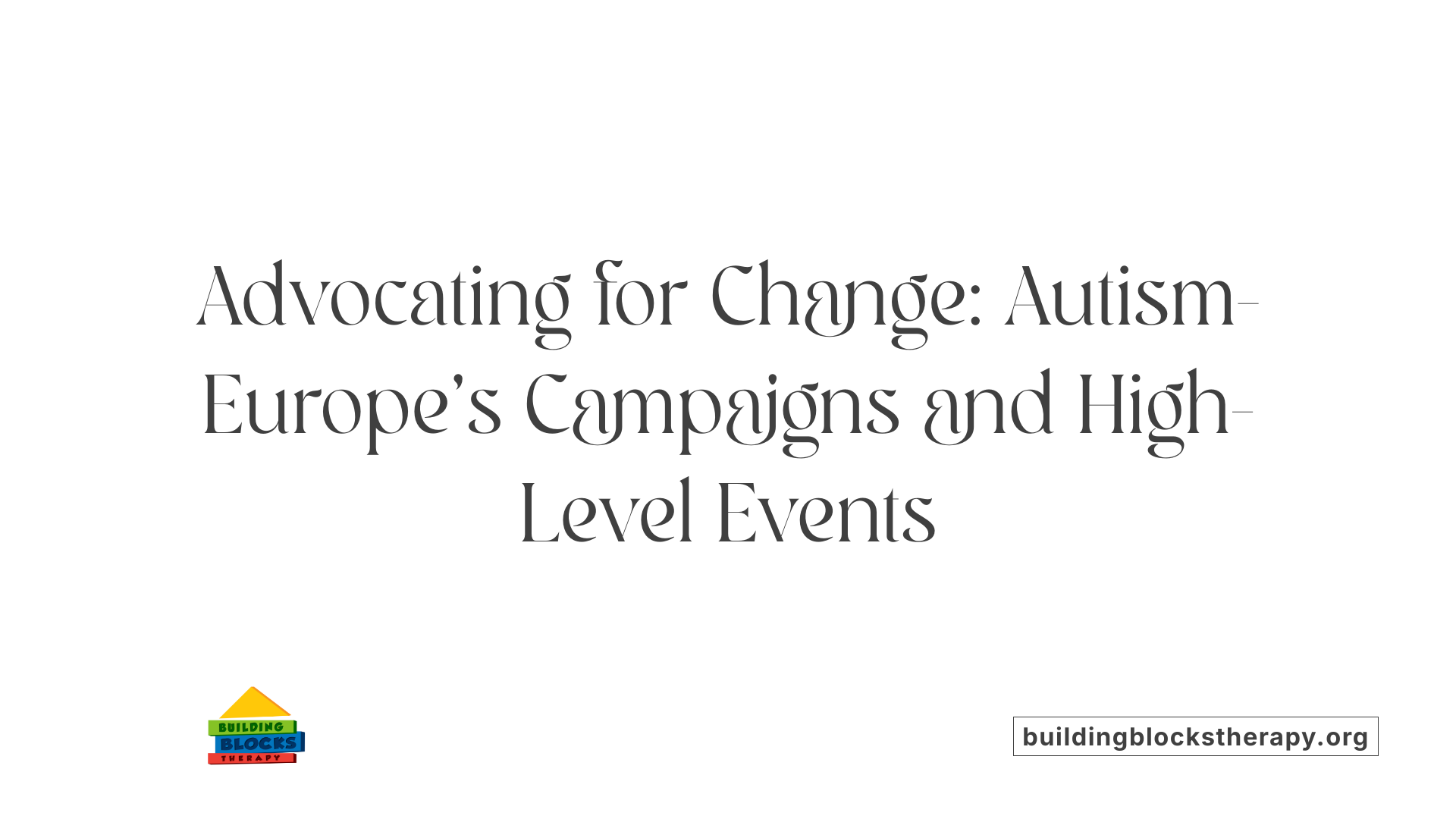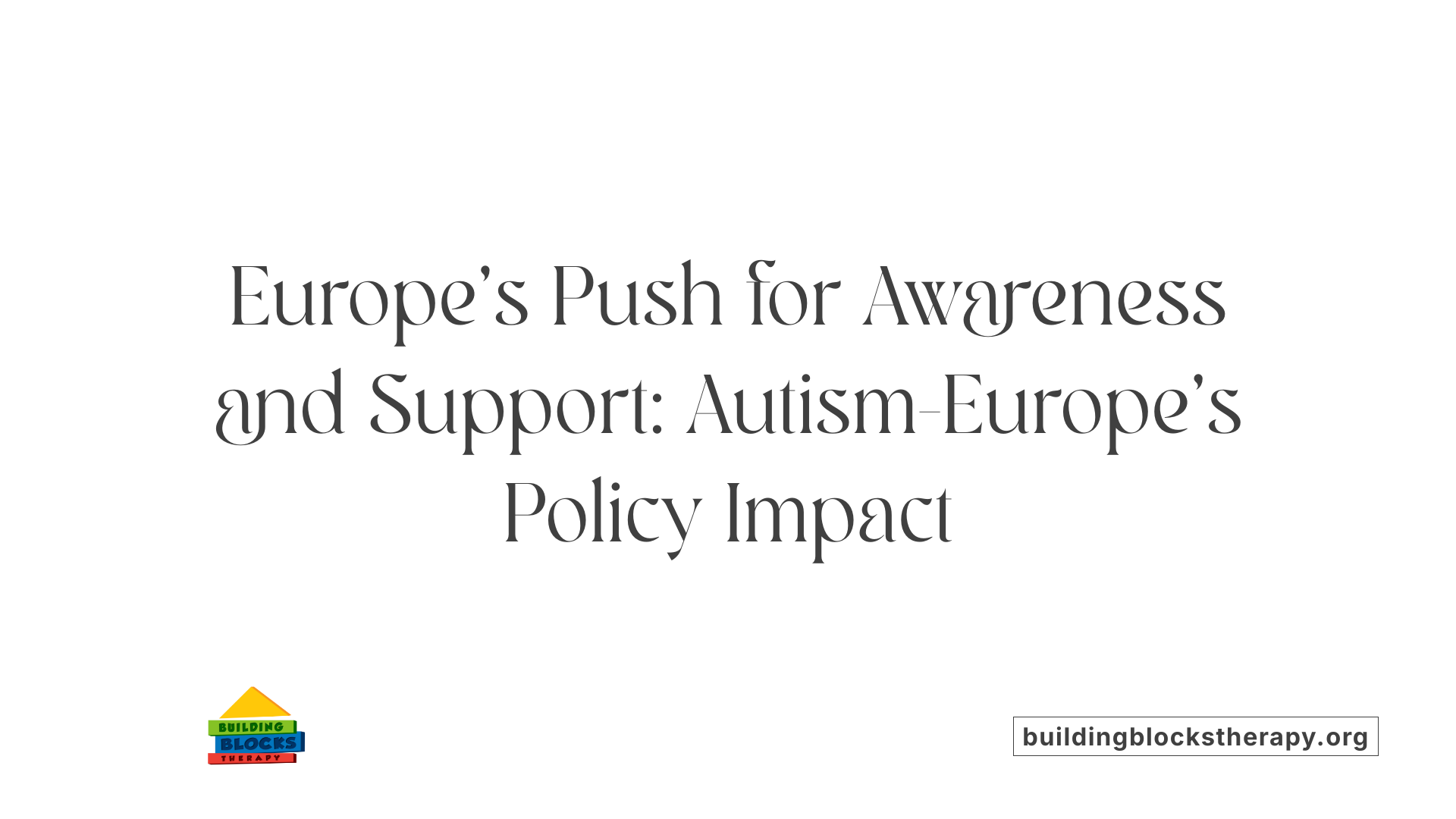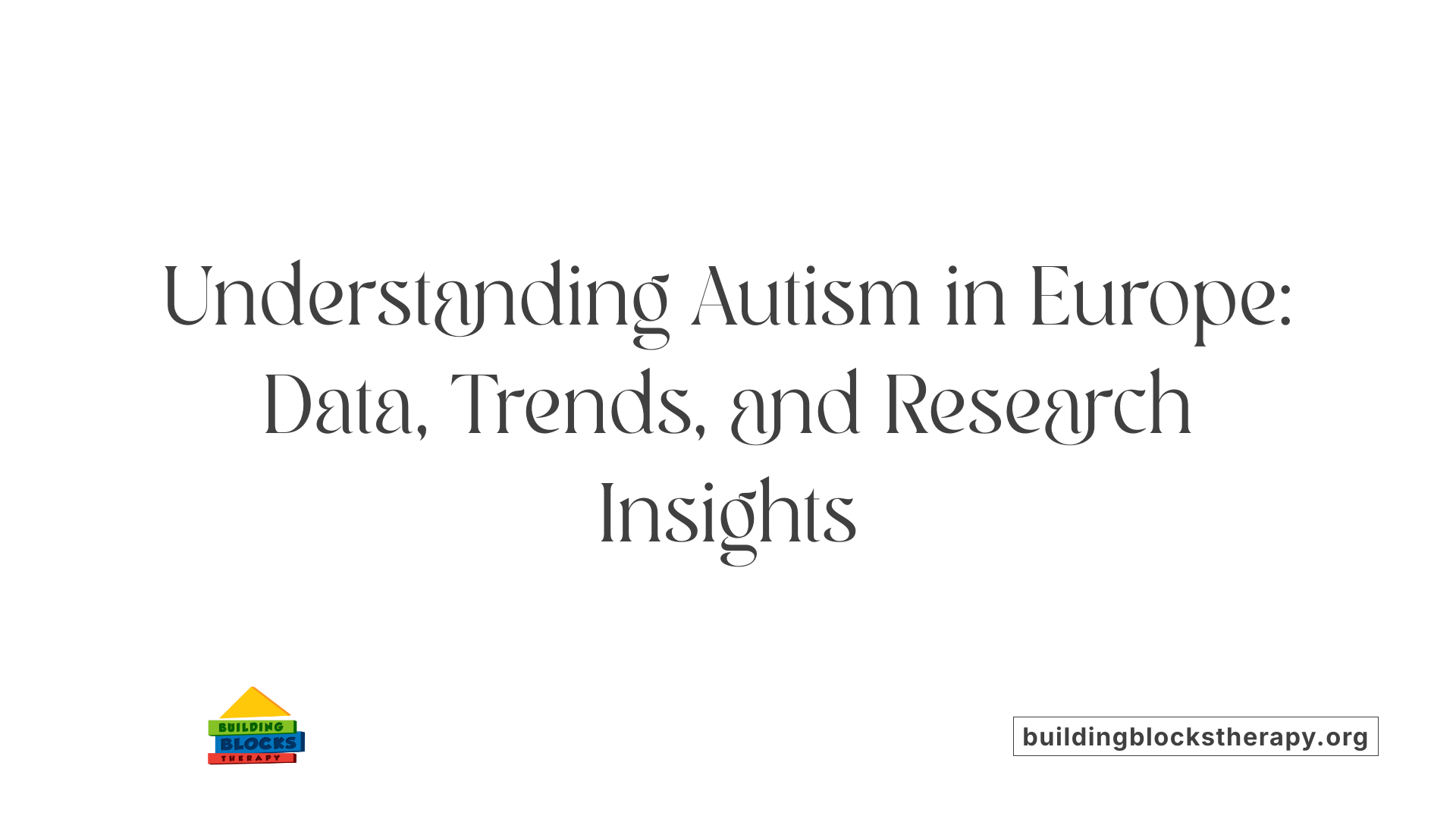Autism In Europe
A Comprehensive Look at Autism Across Europe: Challenges and Progress

Understanding the Landscape of Autism in Europe
Autism spectrum disorder (ASD) is a complex neurodevelopmental condition affecting millions across Europe. Tracing the evolution of research, public health policies, societal perceptions, and advocacy initiatives reveals both the progress made and the challenges that remain in ensuring equitable support and understanding for autistic individuals.
The Mission and Activities of Autism-Europe
 Autism-Europe is dedicated to enhancing the lives of autistic individuals and their families across Europe. Their primary mission is to promote understanding, rights, and inclusion by advocating for systemic changes in societal policies and practices.
Autism-Europe is dedicated to enhancing the lives of autistic individuals and their families across Europe. Their primary mission is to promote understanding, rights, and inclusion by advocating for systemic changes in societal policies and practices.
To achieve this, Autism-Europe actively engages in various campaigns and advocacy efforts. They participate in awareness initiatives such as the 'Not Invisible' campaign, which aims to amplify autistic voices and challenge societal stigma. Events like World Autism Awareness Day are also key platforms used by the organization to raise public consciousness and foster a more inclusive environment.
Beyond advocacy and campaigns, Autism-Europe is heavily involved in European projects that seek to improve access to services and promote social integration for autistic people. They also organize high-level events, including conferences at the European Parliament, to influence policymakers and promote reforms. These initiatives are designed to create a more accessible and equitable society, ensuring that around 7 million autistic individuals in Europe receive the support and recognition they deserve.
European Advocacy and Policy Initiatives

What advocacy efforts are underway to increase awareness and improve support for autistic people across Europe?
Across Europe, organizations and institutions are actively promoting awareness and improving support systems for autistic individuals. The leading entity in this effort is Autism-Europe, which represents nearly 90 associations and individual members from 38 countries. Autism-Europe advocates for the rights of autistic people through various campaigns and projects. Notable initiatives include #AutismDay2025 and the 'Not Invisible' campaign, which aim to foster societal understanding and acceptance.
Autism-Europe works closely with European decision-makers to influence policies and ensure the implementation of international agreements like the UN Convention on the Rights of Persons with Disabilities. Their role includes monitoring progress and urging policy changes that benefit autistic individuals.
In addition to advocacy and policy influence, Autism-Europe engages in collaborative projects such as ACTIVATE, which focus on empowering autistic people and reducing societal barriers. They partner with universities, international bodies, and community groups to raise awareness through education programs, digital outreach, and community engagement. These combined efforts contribute to a more inclusive environment where autistic people have better access to services and greater societal acceptance.
Through these multifaceted campaigns and collaborations, Europe is making strides toward enhanced support, understanding, and rights for autistic individuals, although challenges remain in service access and policy implementation across different countries.
Current State of Autism Research in Europe

What is the current state of autism research, data, and epidemiology in Europe?
Recent studies indicate that autism spectrum disorder (ASD) affects roughly 0.5% of the European population. This estimate comes from a comprehensive meta-analysis involving data from over 17 million individuals across various European countries. Over the last 30 years, the reported prevalence of ASD has risen sharply, a trend that many experts attribute to increased awareness, evolving diagnostic criteria, and earlier detection practices. These factors have contributed to more accurate and timely diagnoses.
Prevalence rates, however, differ across countries—ranging from about 0.35% in Poland to over 1.2% in Spain—reflecting variations in screening methods, research designs, and cultural factors. Countries with more rigorous research protocols tend to report higher prevalence, highlighting the need for standardized methodologies across Europe.
European research initiatives, such as those undertaken by the Autism Societies and the Autonomous Surveillance for Developmental Disorders (ASDEU), are emphasizing the importance of harmonized data collection. These efforts aim to better understand how ASD prevalence changes over time and how resources should be allocated for support and services.
In terms of age groups, studies show that prevalence is higher among children aged 6 to 12 years (about 0.82%) compared to younger children under 5 (about 0.60%) and older adolescents and adults (around 0.57%). This suggests that diagnostic practices and awareness are improving especially among school-age children.
Overall, the current landscape of autism research in Europe underscores a rising prevalence trend, underscores the importance of early diagnosis, and highlights the need for coordinated epidemiological studies. These efforts are vital for developing effective public health strategies, improving service provision, and reducing disparities across countries.
Autism Prevalence and Data Trends in Europe
What are the autism prevalence rates and statistical trends across different European countries?
Recent research indicates that the overall prevalence of autism spectrum disorder (ASD) in Europe is approximately 0.73%, with some variation depending on the country and methodology used in studies. For example, in European countries with extensive research, the prevalence is reported around 0.90% in Sweden and 0.73% in Denmark. In contrast, Poland has reported lower prevalence estimates, whereas Romania's figures are notably higher at 14.3%, reflecting differences in diagnostic criteria and data collection methods.
Over the past three decades, the prevalence of autism in Europe has shown a marked increase. In the 1990s, rates were estimated around 0.2%, but recent data from 2015 to 2019 suggest an increase to roughly 0.99%, with certain high-income regions showing even higher estimates—up to 1.18%. This rise is attributed to factors such as increased awareness, changing diagnostic standards, earlier identification, and demographic shifts.
Across Europe, prevalence among children aged 6–12 years is higher at approximately 0.82%, compared to children under 5 years (0.60%) and adolescents over 13 years (0.57%). These figures highlight the importance of early diagnosis and the ongoing challenges in capturing accurate prevalence data across different age groups.
How do prevalence rates differ among genders?
Research consistently shows that autism affects males significantly more often than females. The reported prevalence among males is about 2.1%, while among females, it is approximately 0.6%. This disparity underscores potential gender differences in diagnosis or presentation of symptoms, and suggests that females may face greater hurdles in accessing diagnosis and related services.
Differences in service accessibility, as well as social and diagnostic biases, contribute to this gap. Addressing these disparities is crucial for ensuring equitable support for all autistic individuals.
| Aspect | Prevalence Estimate | Notes |
|---|---|---|
| Overall prevalence in Europe | 0.73% | Based on recent meta-analyses |
| Highest reported in Europe | Sweden (0.90%), Denmark (0.73%) | Variability due to methodology |
| Lower estimates | Poland (lower than 0.73%) | Reflects differences in research approaches |
| Prevalence in high-income countries | 0.79–1.18% | Higher due to better detection and awareness |
| Gender prevalence (males) | 2.1% | Compared to females at 0.6% |
| Gender prevalence (females) | 0.6% | Potential underdiagnosis or differing symptom presentation |
These trends underscore the importance of continued research and policy efforts to improve autism awareness, diagnosis, and service provision across Europe.
Public Health Policies and Support Services in Europe

What public health policies and services are available for autistic individuals in Europe, and how accessible are they?
Across Europe, policies addressing autism differ from country to country but generally focus on promoting inclusive education, early diagnosis, and tailored support systems. Countries like the UK, France, and Spain have developed specific strategies aligned with international standards, such as the Convention on the Rights of Persons with Disabilities (CRPD). These policies aim to uphold the rights of autistic individuals to access appropriate healthcare, education, and social participation.
Despite these efforts, access to support services varies significantly across the continent. Reports indicate that many autistic people face long waits — sometimes over six months — for essential services such as therapy, mental health support, diagnostic assessments, and financial assistance.
Barriers to access are often due to limited service availability and strict eligibility criteria, which can exclude those in need. For example, countries like Poland and the UK experience more pronounced difficulties, with lengthy delays and unavailability of services. Conversely, nations like Spain and Germany demonstrate more reliable access, although disparities still exist.
Healthcare systems strive to adapt to the sensory, social, and communication needs of autistic individuals, especially amid challenges posed by the COVID-19 pandemic. Efforts are underway at both national and European levels to improve coordination and resource allocation. However, ensuring equitable, timely support remains an ongoing challenge.
Enhancing service accessibility involves not only increasing availability but also reducing disparities linked to geographic location, gender, and age. Addressing these issues requires comprehensive policy reforms and innovative care models that prioritize inclusivity and early intervention.
More information about support services in Europe can be found by searching for
Cultural Perceptions and Societal Challenges
How do cultural perceptions and societal challenges affect autism diagnosis and treatment in different European regions?
Across Europe, cultural perceptions of autism greatly influence how the condition is diagnosed and treated. In some regions, autism is well understood and accepted, leading to early diagnosis and access to supportive services. Conversely, in areas where autism is misunderstood or stigmatized, families may hesitate to seek diagnosis or support due to fear of social exclusion or negative stereotypes.
Societal challenges such as stigma and low awareness contribute to significant disparities in access to care. In countries or communities where awareness is limited, early intervention services are often delayed or unavailable, particularly in rural or underserved regions. This can result in missed opportunities for developmental support during crucial early years.
Moreover, variations in healthcare infrastructure and the availability of trained professionals influence how efficiently autism is diagnosed and managed across different parts of Europe. Wealthier nations tend to have more comprehensive services, while lower-resourced areas face longer wait times, fewer specialized providers, and fragmented support.
Cultural and societal attitudes also affect public policies and funding for autism-related services. Countries with positive societal perceptions are more likely to implement inclusive policies and allocate resources for autism support programs. Conversely, areas with persistent stigma may struggle with legislative support and resource allocation, hindering progress.
In summary, understanding and addressing these cultural perceptions and societal challenges is critical. They shape the willingness of families to seek diagnosis, influence the quality of available treatment, and determine how societies support autistic individuals. Overcoming these barriers requires targeted awareness campaigns and policy efforts tailored to regional contexts, promoting acceptance and improving access across Europe.
The Impact of COVID-19 on Autism Services and Support
What disruptions and adaptations have occurred in autism services due to the COVID-19 pandemic?
The COVID-19 pandemic brought about significant challenges for autism services across Europe. Lockdowns and social distancing measures resulted in widespread delays in diagnosis, therapy sessions, and ongoing support programs. Many individuals faced long wait times—sometimes exceeding six months—for critical services such as mental health support, needs assessments, and educational assistance.
The unavailability of face-to-face interventions was particularly disruptive for children who rely heavily on direct therapies and educational support. As a result, many felt isolated and faced increased difficulty in accessing the necessary services that help them thrive.
Despite these setbacks, the crisis also prompted rapid innovations. Healthcare providers and organizations quickly adopted digital solutions, including teletherapy, virtual diagnostic assessments, and online support groups. These adaptations proved vital in maintaining continuity of care when traditional services were inaccessible.
This shift to remote support showcased both vulnerabilities in existing healthcare systems and new opportunities for innovation. It highlighted the importance of resilience and flexibility when delivering autism support services. Moving forward, integrating remote options into standard practice could make services more accessible, particularly in times of crisis or for those living in remote areas.
Ultimately, the pandemic underscored the urgency of building more adaptable, inclusive systems that can ensure uninterrupted support for autistic individuals and their families, regardless of external disruptions.
Promoting Inclusion and Society-Wide Acceptance
How can community efforts foster social acceptance and inclusion for autistic individuals?
Community initiatives are essential in promoting understanding and inclusion of autistic individuals. These programs often involve awareness campaigns, educational workshops, and school-based activities designed to challenge stereotypes and dispel myths surrounding autism.
Local communities can implement inclusive educational practices that normalize neurodiversity. This includes integrating social skills training and inclusive curricula in schools, creating a welcoming environment where autistic children and adults can participate fully.
Participatory activities—such as local events, festivals, and awareness days—serve as platforms to celebrate neurodiversity. Events like World Autism Awareness Day bring attention to the needs and talents of autistic individuals, fostering greater acceptance.
Success in fostering inclusion also depends on collaboration among families, local authorities, and organizations like Autism-Europe. These groups work together to develop and support initiatives that promote social participation.
Peer support programs, which connect autistic individuals with members of the broader community, help build social skills and confidence. Such programs often involve community volunteers and can be expanded through public awareness campaigns.
Local authorities and community organizations often organize workshops and informational sessions that educate the wider public about autism. This helps reduce stigma and promotes empathy.
Inclusion efforts are further strengthened when they are culturally sensitive and accessible to diverse populations, ensuring no one is left behind.
Overall, community efforts that focus on awareness, education, participation, and collaboration are instrumental in creating a society that values neurodiversity and fosters acceptance of autistic individuals.
How do community initiatives impact social acceptance for autistic individuals?
Community initiatives foster a sense of belonging among autistic people and their families. They help normalize differences and emphasize the strengths and talents of autistic individuals.
Such efforts lead to increased opportunities for employment, education, and social engagement, thereby reducing isolation. When communities actively promote inclusivity, autistic individuals can access resources and support that improve their quality of life.
In summary, community-driven efforts—ranging from awareness campaigns to inclusive programs—are crucial in building a society that celebrates diversity and ensures all individuals are respected and valued.
| Initiative Type | Purpose | Example | Impact |
|---|---|---|---|
| Awareness Campaigns | Challenge stigma, increase understanding | World Autism Awareness Day | Greater acceptance and support |
| Educational Programs | Promote inclusive learning | School-based neurodiversity programs | Increased social skills |
| Participatory Events | Celebrate neurodiversity | Local festivals and events | Community engagement, visibility |
| Support Networks | Foster peer connections | Autism support groups | Reduced social isolation |
Challenges and Recommendations for Future Policy and Practice
What are the main challenges in supporting autistic people in Europe, and what strategies could address these issues in the future?
Supporting autistic individuals across Europe presents multiple hurdles that impact their access to necessary services and support systems. One of the primary challenges is the significant disparity in service availability and quality among different countries and regions. Many individuals face long waiting times—sometimes exceeding six months—for critical services such as therapy, diagnostics, and educational support.
In addition, resource limitations and cultural barriers often hinder effective service delivery. Variations in healthcare infrastructure, economic disparities, and differing societal attitudes toward autism contribute to an uneven support landscape. Data collection methods also vary across countries, making it difficult to accurately assess needs and allocate resources effectively.
To combat these issues, policymakers and stakeholders should prioritize the standardization of data collection and research methods across Europe. Increased investment in early diagnosis, intervention, and support services is essential to ensure equitable access.
Strategic initiatives should include fostering cross-country collaborations to share best practices and develop unified standards. Expanding digital and community-based services can help reach underserved populations, especially in remote or rural areas. Raising awareness and providing targeted training for healthcare professionals, educators, and social workers can improve the quality of support.
Furthermore, addressing societal acceptance and tackling gender disparities—such as the higher likelihood of women being unable to access multiple services—is crucial. Embedding the rights of autistic people into broader public policies will help promote societal inclusion.
These coordinated efforts among governments, civil society, and international organizations can create a more inclusive environment. By implementing these strategies, Europe can improve service accessibility, reduce inequalities, and enhance the overall quality of life for autistic individuals and their families.
Moving Towards an Inclusive Future for Autism in Europe
While significant strides have been made in understanding, diagnosing, and supporting autistic individuals across Europe, persistent disparities remain. Advocacy organizations like Autism-Europe continue to lead efforts in promoting awareness, influencing policy change, and fostering societal acceptance. Improved data collection, equitable access to services, and inclusive policies are vital for ensuring that autistic individuals can thrive. Addressing cultural perceptions and implementing innovative, resilient services will be essential to creating a more inclusive society that recognizes and celebrates neurodiversity. The ongoing collective effort of policymakers, communities, and advocacy groups will shape a future where autism is understood, supported, and embraced across all regions of Europe.
References
- Autism Europe
- Prevalence rate of autism
- Access to services for autistic people across Europe
- The global prevalence of autism spectrum disorder: A three ...
- Prevalence rate of autism
- The global prevalence of autism spectrum disorder: A three ...
- Prevalence of autism in Europe, North America and Oceania ...
- The Prevalence of Autism Spectrum Disorder in Europe
- Autism Europe
- Rights promotion






